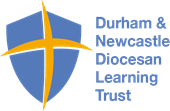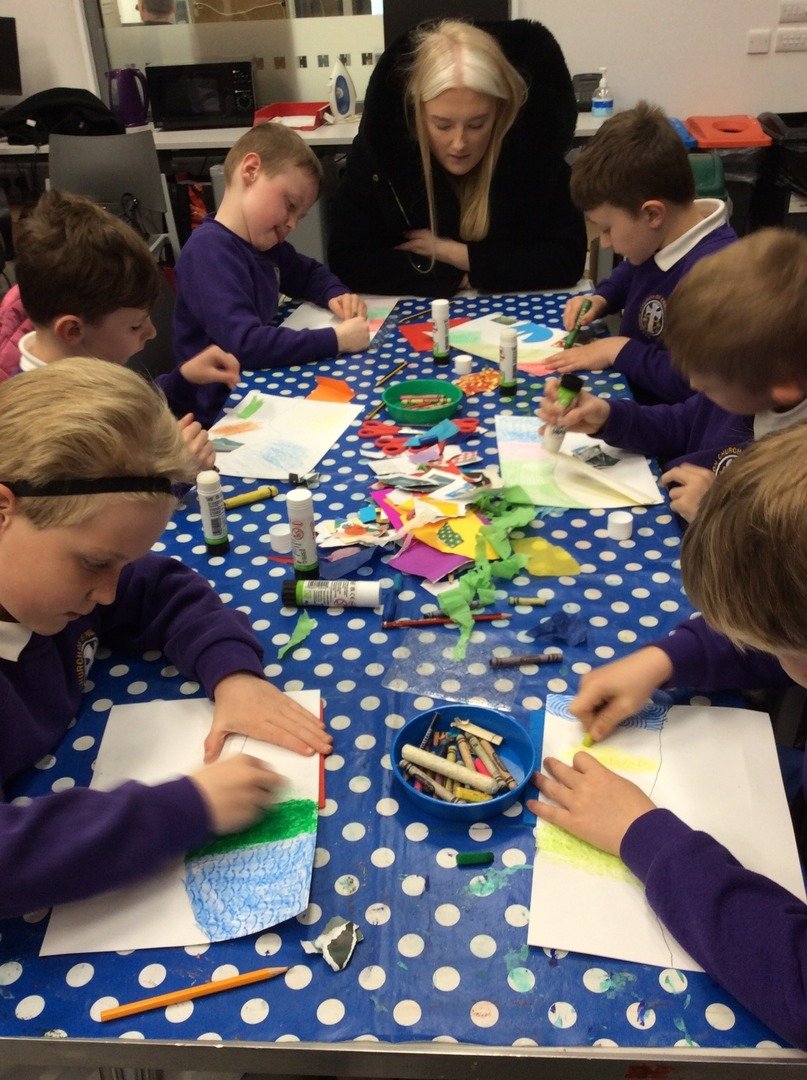Art in School
Laing Art Gallery
4Y had a fantastic trip to the Laing Art Gallery. They took part in a fantastic watercolour workshop and even got the chance to explore the Turner exhibition. They all had such a lovely time and lots of members of the public commented on how well behaved the children were in the gallery.
Fun with clay
Year 4 have continued their theme of volcanoes in Art but this time they have been working with clay. They have each carved their own volcano image into a piece of clay to create their own decorative tile. Their pieces look amazing and are now on proudly on display.
Landscapes
Year 4 were inspired by the work of artist Bob Ross. Mr DeRosa lead the whole year group in a live exercise in painting a landscape.
Mark Rothko
In Art, Year 2 have learnt about the artist Mark Rothko and his style of paintings. They practised mixing primary and secondary colours together before creating their own 'colour fields' using watercolour paints.
Monochrome Landscapes
Year 4 have had a fantastic afternoon exploring charcoal. They experimented with different techniques before drawing some monochrome landscapes. Their finished pieces look amazing!
Nature Inspired Artwork
Our Year 6 children have created artwork inspired by British artist Goldsworthy known for his site-specific installations involving natural materials and the passage of time.
Art Club
The children have been doing some fabulous work in Art club! They have been looking at shading techniques to help add more detail to their drawings. Maybe we have some budding Warhol's, Emin's or Michelangelo's in the making?
Hatton Art Gallery
The children in Year 3 had the opportunity to visit the Hatton Art Gallery on Wednesday to take part in an Art workshop. They really enjoyed the journey on the Metro and exploring the artwork on display. They looked at abstract, canvas and sketch work by the artist Wilhelmina Barns-Graham. They had the opportunity to then produce their own artwork using collage
Year 4 Ansel Adams
U.S. photographer Ansel Adams was famous for his striking images of Western landscapes. He was among the first people to promote photography as an art form. Adams also was known for his love of nature. We were inspired to use photographs from nature to create these fantastic collages.
Year 3 Pop Art
We have been learning about different artists this term including Modigliani, Picasso and Andy Warhol. Last week we traced the famous Campbells soup can and today using oil pastels we added our vibrant colours to replicate the artists signature style.
Modigliani
The children in Year 3 were inspiered by the artwork of Amedeo Modigliani, an Italian painter and sculptor who worked mostly in Paris, Modigliani is best known for his portraits, which can easily be recognized because of their elongated noses and necks and their long slender faces.
Year 2 Portrait
In Year 2 we are focusing on portraits this half term. Each child drew a self-portrait with very little guidance from their teacher. This was step 1. We then discussed our portraits with our partners and thought about how we could make them more realistic. We decided that drawing the eyes was especially tricky! Our teachers taught us how to sketch eyes using a range of techniques. You can click the video below if you would like to learn how to draw realistic looking eyes. Step 2 was to practice drawing eyes and other facial features.
Tudor Art
The children in Year 5 have worked so hard on these sculptures of Tudor figures. We used a range of techniques and skills as well as some art materials we had not used before. We think you will agree that the finished sculptures are a reflection of our hard work!
Year 4 Mosaic
Our Year 4 children have linked their art to their history topic which is The Romans. They designed, made and evaluated their own mosaic pictures.
Artists from Around the World
Kusama Yayoi, born 22 March 1929) is a Japanese contemporary artist who works primarily in sculpture and installation, but is also active in painting, performance, film, fashion, poetry, fiction, and other arts. Her work is based in conceptual art.
We were inspired by her love of bright colours, complex backgrounds and spotty designs.
Colour Mixing

If you combine two primary colours, you create something called a secondary colour. For example, mixing red and blue produces purple; yellow and red makes orange; blue and yellow combined make green; red and blue make purple. ... If you mix three primary colours, you get black.
Working with Charcoal
This week Year 2 worked with willow charcoal sticks. This type of charcoal is made from natural willow wood. It’s generally quite soft which makes it great for free flowing strokes and blending. We practiced using this new media before we used it to create an observational drawing of St Paul's Cathedral.
Pablo Picasso - Cubism
The children in Year 2 have been looking at the artwork of Pablo Picasso. Some of his most recognisable pieces were created in the cubist style. Cubism is a style of art which aims to show all of the possible viewpoints of a person or an object all at once. It is called Cubism because the items represented in the artworks look like they are made out of cubes and other geometrical shapes. When working in this style the children had to consider:
- bold colours
- block colour
- bold, black lines
- different proportion
- strange placement
- strong shapes
Romero Britto - Neo-pop
Romero Britto (1963- present), born in Brazil, is known for his neo-pop artwork. A self-taught artist, Britto “combines elements of cubism, pop art and graffiti painting in his work, using vibrant colours and bold patterns as a visual expression of hope and happiness”. Romero Britto has created work for many popular brands and his work is also displayed in many popular places, such as airports.
Year 2 were inspired by his emoji work.
Self-Portrait
In the past, portraits were mostly used to memorialize rich and powerful people like kings and queens. This meant the world would remember them after they died. An artist often tries to show the person’s character so a portrait might show how important someone is, or how kind, or strong.
A self-portrait is when the artist creates a piece of work showing themselves. Self-portraits are actually a key part of learning and personal development. Creating a self portrait gives the children a chance to explore shape and form, it provides a freedom for them to represent themselves and show how they see themselves. Most importantly self portraiture is about creating something for themselves, and not worrying about what other people think or how they may respond. Children will learn that doing art is, at its best, quick, simple and enjoyable.
Hope Project
During lockdown our children were invited to create a piece of artwork showing their lockdown experiences. Working with local artist Greg McGee as their guide they created some amazing portraits detailing their life in the midst of the Covid pandemic.
The children's art work will be combined and made into an art installation to be displayed in school.




















































































































































































































































































